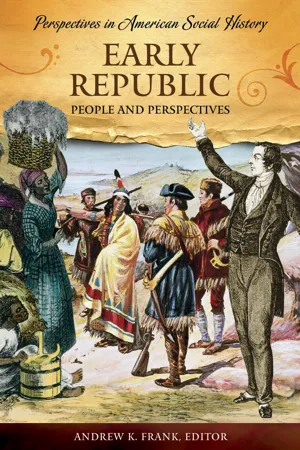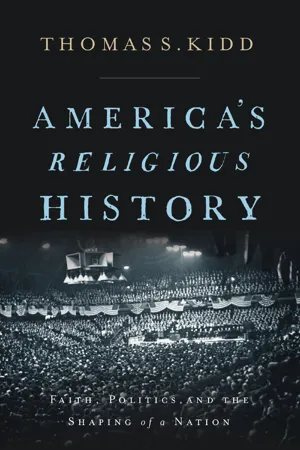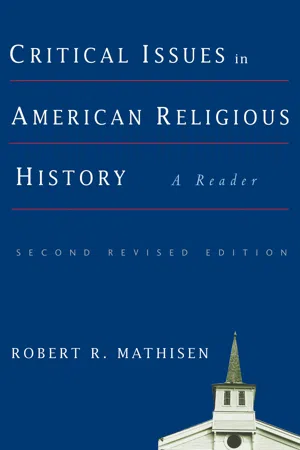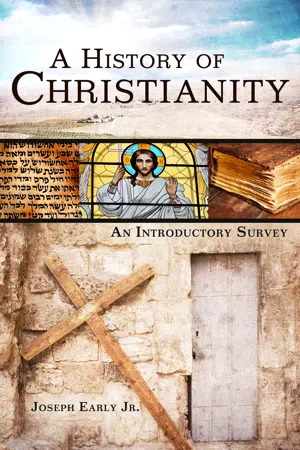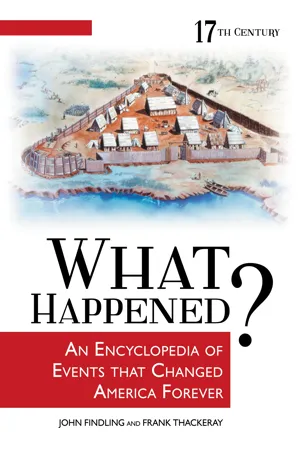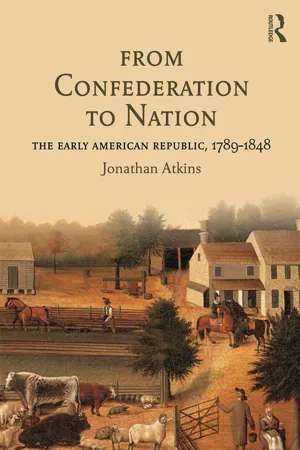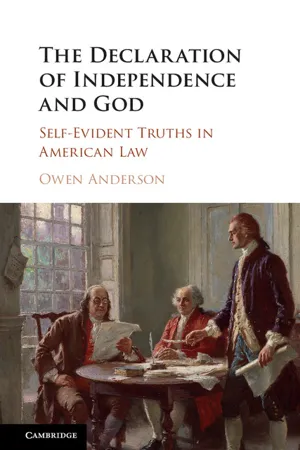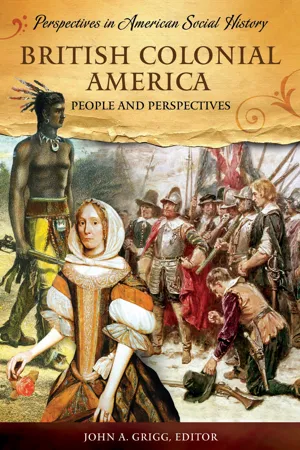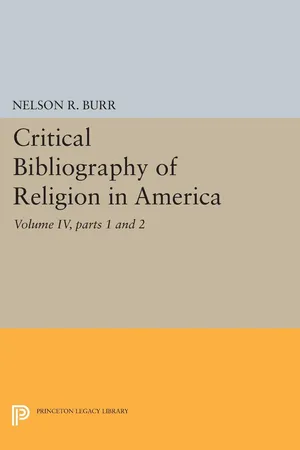History
Second Great Awakening
The Second Great Awakening was a religious revival movement in the United States during the early 19th century. It emphasized individual salvation, emotional preaching, and a focus on personal piety and morality. The movement had a significant impact on American society, contributing to the rise of various reform movements, including abolitionism and women's rights.
Written by Perlego with AI-assistance
Related key terms
1 of 5
12 Key excerpts on "Second Great Awakening"
- eBook - PDF
Early Republic
People and Perspectives
- Andrew K. Frank(Author)
- 2008(Publication Date)
- ABC-CLIO(Publisher)
The Fires of Evangelicalism in the Cauldron of the Early Republic: Race, Class, and Gender in the Second Great Awakening Anna M. Lawrence 9 Introduction The era of the Second Great Awakening encompasses a long period of revi- talization and growth for Protestant American churches. This growth occurred through a series of small and large evangelical revivals, which took place throughout the country but were particularly focused in the areas of west- ward expansion. At these revivals, converts committed themselves to God and sometimes experienced a so-called rebirth into new religious lives. This movement reflects the major themes of the early republic: westward expan- sion, industrialization and market growth, and the country’s democrati- zation on a variety of levels. In terms of religious history, this period was instrumental in establishing what would become the modern religious land- scape, a competitive and diverse spiritual marketplace. The Second Great Awakening established America’s tremendous religious variety, the domi- nance of evangelical Protestantism, and freedom from state control, all char- acteristics that have come to define modern American religious life. This movement occurred over a long span of time, starting in the late 1790s and extending into the 1840s. Revivals occurred in both urban and rural settings, in the North, South, East, and West. Unlike the Great Awak- ening of the 18th century, a much broader, more diverse group of people were involved in the Second Great Awakening, including a significantly larger proportion of African Americans. In fact, one of the most important outcomes of this movement is the extent to which African Americans formed their own churches and separate leadership structures. In addition, the effect of democratization can be seen in the fact that women were many of the central actors of this awakening. The movement challenged racial hierarchies in some arenas and social hierarchies in others. - eBook - ePub
America's Religious History
Faith, Politics, and the Shaping of a Nation
- Thomas S. Kidd(Author)
- 2019(Publication Date)
- Zondervan Academic(Publisher)
Chapter 4THE ERA OF THE SECOND GREAT AWAKENINGBy the year 1800, American Christianity, in tandem with the nation’s population, entered a new phase of westward growth and organization. The nation’s progress into the West displaced many Native Americans and precipitated the monumental Louisiana Purchase of 1803, by which the United States roughly doubled in size. Even before the Louisiana Purchase, white settlers surged into the Ohio River Valley region and the Deep South. By the 1840s, westward settlement spread out to California and the Oregon Territory, with people seeking gold and more farmland. Churches and itinerant pastors kept up with and even surpassed the pace of settlement, and they sometimes sought to address the plight of displaced Native Americans. Led by the Methodists and Baptists, churches socially organized the West on the ground level.The Second Great Awakening was punctuated by massive revivals. These included its seminal event, the Cane Ridge Revival in Kentucky in 1801. Revivals often resulted in significant seasons of church growth. More than a series of revivals, the Second Great Awakening was also a process by which millions of Americans came into the fold of Christiancongregations. Sometimes attending a revival was a critical part of the process for those who became devout church members. Just as important over the long term were the quieter labors of hard-working ministers who spread through the Midwest, Southwest, and ultimately the Far West. Town by town, family by family, they gave frontier people a message of gospel hope. They also provided them with a local church, which often represented the only regular social outlet that frontier families had.Countless preachers and Christian laypeople participated in the frontier expansion of Christianity. For example, Joseph Willis was a former slave turned Baptist pastor, who may have delivered the first Protestant (or at least Baptist) sermon west of the Mississippi River. Willis received his freedom in 1787, the year of the Constitutional Convention in Philadelphia. Willis went from South Carolina into the Mississippi Territory and then into Louisiana. Napoleon Bonaparte of France acquired the vast Louisiana Territory, which included the future state of Louisiana, from Spain in 1800. Willis arrived in Louisiana around the time that President Jefferson arranged to procure the territory from France. - eBook - PDF
Critical Issues in American Religious History
A Reader, Second Revised Edition
- Robert R. Mathisen(Author)
- 2006(Publication Date)
- Baylor University Press(Publisher)
85 Few events in American history have produced so many conflicting percep-tions and seemingly irreconcilable interpretations as the series of religious revivals in the late 1730s and early 1740s known as the Great Awakening. To revivalists like Jonathan Edwards, the Awakening was “an extraordinary and mighty Work of God’s Special Grace.” Its fruits included the transformation of society and the saving of individual souls. “When once the Spirit of God began to be so wonderfully poured out in a general way through the Town [Northampton],” he wrote, “People had soon done with their old Quarrels, Backbitings, and Intermeddling with other men’s Matters.” Among Edwards’s antagonists, however, the Awakening was some-thing quite different—a confusion that produced “enthusiastic Heat” and “Commotion in the Passions.” Not only did it fail to reform hearts and minds, but, wrote Charles Chauncy, a Boston cleric, “Tis not evident to me that Persons . . . have a better Understanding of Religion, a better Government of their Passions, a more Christian love to their Neighbour, or that they are more decent and regular in their Devotions toward God.” For all the verbal sparring between Edwards, Chauncy, and many clergy and laypersons of their time, more recently the larger question has been raised as to the historical reality of the phenomenon now labeled “the Great Awakening.” In 1982, Jon Butler caught the attention of colonial historians with his suggestion that the Awakening was an “interpretive fiction,” con-ceived by the minister-scholar Joseph Tracy, who first used the term “Great Awakening” in his 1841 publication by that title. Tracy produced his work, Butler contends, to support America’s nineteenth-century revivals, particu-larly the “Second Awakening” then in process. Chapter 3 The Era of the Great Awakening Issue: What was the meaning of the Great Awakening? d - eBook - ePub
Religion and the American Experience: A Social and Cultural History, 1765-1996
A Social and Cultural History, 1765-1996
- Donald C. Swift(Author)
- 2016(Publication Date)
- Routledge(Publisher)
In New England, another central focus of revivalist activities was the enlistment of people in a crusade to arrest the decline of the influence of organized religion and to create a Christian America. While many New England Calvinist clergy hoped revivalism would restore what they saw as eroding status and authority, clergymen wanted the full measure of power and standing enjoyed by their predecessors. Laymen who had been exhorted to take leading roles in voluntary benevolence were not as likely to dutifully await clerical guidance or view clergymen as intermediaries between God and men. Lyman Beecher, a Dwight student, was to become a leader of revivalistic activities in New England and the West. He was an unusually capable organizer, skillful at spreading the evangelical message through the printed word. In time, Beecher and others would successfully redirect evangelical efforts toward upholding the new economic order and removing "antimammon" elements from New Divinity theology.In the South, both blacks and whites attended revivals in large numbers; frequently whites were outnumbered by blacks at these gatherings. Here and there mostly white congregations acquired spellbinding African American preachers. Egalitarianism and populism would characterize the early decades of the Second Great Awakening in the South and West.The Second Awakening
Christianity's role in American life expanded greatly in the nineteenth century as evangelism came to dominate American Protestantism. For many, it was a means of revitalizing their belief systems, which seemed threatened by deism, western infidelity, economic development, and democratic challenge to established institutions. The Second Great Awakening, spanning the first half of the century, brought mass evangelism to almost every part of the nation. (Some have placed the Awakening in the years 1780-1830).This great outburst of evangelical revivalism marked the democratization of American Protestantism. People rejected formal doctrines and selected their own religious spokesmen, who frequently lacked theological education, or even formal education beyond elementary school. Although Mormons and Methodists had hierarchies, the thrust of the revivalistic activities was democratic because the revivalists condemned social distinctions. All believers were encouraged to give testimony regarding their religious experiences. Spiritual ecstasy or the "enthusiasm" that the Puritans had so detested now became respectable. Traditional hymns often gave way to spirited songs that resembled African American spirituals. Not only the songs but the manner in which they were sung, and the emotions they unleashed, reflected the profound influence of African American spirituality on the Second Great Awakening. The impact of African American spirituality was particularly strong among early Methodists; the level of religious enthusiasm would later decline as Methodists acquired greater social status. Camp meetings could be seen as "festivals of democracy." Clergy were no longer viewed as mediators between God and man, and the impression was given that the revivalists had restored the Bible as the basis for belief. The primacy of the individual conscience was emphasized, and revivalists preached that holiness was reserved for the poor and humble in spirit rather than the proud and rich. - eBook - PDF
God's Democracy
American Religion after September 11
- Emilio Gentile(Author)
- 2008(Publication Date)
- Praeger(Publisher)
It was, however, a personal type of religion, an individual type, emotional more than doctrinal; often it did not belong to the traditional confes- sions and institutional places of worship, and so it corresponded to the growing diversity of American religions, making the changing pattern of a new religious America so unique. 39 Impressed by the sudden growth in church attendance and intensified devout- ness in America following September 11, the most important exponents of tradi- tional and fundamentalist evangelicalism stated triumphantly that America was The Great Awakening 109 more religious once again. Jerry Falwell predicted that the Americans were about to devote themselves to God at long last, and Pat Robertson announced that there was occurring one of the greatest spiritual awakenings in the history of America. 40 The general American phrase “Great Awakening” indicates the Protestant evangelical movements, born of a renewed faith and religious enthusiasm, to preach individual and collective moral regeneration through a more rigorous observance of the Scriptures in private and public life. In the history of America these movements had preceded and influenced decisive changes in politics. The first Great Awakening, in the mid-eighteenth century, had prepared the structure of American patriotism on the eve of the War of Independence; a Second Great Awakening which developed during the early decades of the nineteenth century had accentuated the evangelical nature of American Protestantism and its democ- ratization, and it contributed to America’s westward expansion with its missionary ardor to evangelize; at the end of the nineteenth century there was talk of a Third Awakening with the spread of millenarian movements. During the last 10 years of the twentieth century, theologians and clergymen thought that America was about to experience another Great Awakening. - eBook - ePub
A History of Christianity
An Introductory Survey
- Joseph Early(Author)
- 2015(Publication Date)
- B&H Academic(Publisher)
Chapter Twenty-FiveThe Second Great Awakening and Its After-EffectsT he Second Great Awakening (1790–1830) had three distinct but interrelated phases. The first occurred at Yale College and affected New England Congregationalism. The second, on the western frontier of Kentucky, Missouri, and Tennessee, was noted for its intense revivals. The third was dominated by Charles Finney’s ministry and revivals.Yale and the New England PhasePresident Timothy Dwight of Yale College (1752–1817), the grandson of Jonathan Edwards, is credited with starting the Congregational phase of the Second Great Awakening. Dwight feared that Yale students were more interested in Deism than Christianity. So along with other professors, he began lecturing and preaching on the truths of Christianity. A revival began in 1802. When it ended, more than seventy of the 225 students at Yale had been converted. The Yale revival then spread to other colleges throughout the United States.1 As Dwight hoped, the revival helped stop the spread of Deism at Yale and in the United States.Nathaniel Taylor (1786–1858), a student at Yale during the revivals, set forth what came to be known as “Taylorism” or “New Haven Theology.” He spoke against the rigid predestination of old-school Calvinism, believing the revivals demonstrated that human freedom played a role in conversion. Everyone was a sinner, but Adam’s sin was not imputed to others, he said. Each human was responsible only for his own sin, and man had the ability to choose whether or not to sin. In 1822 Taylor was named professor of didactic theology at the newly established Yale Divinity School. The father of author Harriet Beecher Stowe (1811–1896), Lyman Beecher (1775–1863) was the most influential proponent for of New Haven theology.While still Calvinistic, New Haven theology represented a step toward Arminianism and continued America’s drift from the theology of its first Puritan settlers. By amending the traditional Calvinist doctrines of original sin and imputation,2 - eBook - PDF
- John E. Findling, Frank W. Thackeray, John E. Findling, Frank W. Thackeray(Authors)
- 2010(Publication Date)
- ABC-CLIO(Publisher)
Their efforts transformed the United States. SELECTED BIBLIOGRAPHY Abzug, Robert H. Cosmos Crumbling: American Reform and the Religious Imagination. New York: Oxford University Press, . Provocative examination of the link between religious revivalism and reform. Ahlstrom, Sydney. A Religious History of the American People. New Haven, CT: Yale University Press, . An older general history of religion in the United States, but encyclopedic in its coverage and well-written. Boles, John B. The Great Revival, –: The Origins of the Southern Evangelical Mind. Lexington: University of Kentucky Press, . Excellent study of the first revivals of the Sec- ond Great Awakening. Butler, Jon. Awash in a Sea of Faith: Christianizing the American People. Cambridge, MA: Harvard University Press, . Invaluable and insightful overview of American religious life between Europeans’ first settlement and the Civil War. Hambrick-Stowe. Charles E. Charles G. Finney and the Spirit of American Evangelicalism. Grand Rapids, MI: W. B. Eerdmans, . Most recent biography of a key figure of the Second Great Awakening. Hatch, Nathan O. The Democratization of American Christianity. New Haven, CT: Yale University Press, . Landmark study of the appeal of evangelicalism in antebellum America. THE Second Great Awakening, 1790–1840 15 Heyrman, Christine Leigh. Southern Cross: The Beginnings of the Bible Belt. New York: Knopf, . A well-written and erudite study of the spread of evangelicalism in the southern states. Johnson, Paul E. A Shopkeeper’s Millennium: Society and Revivals in Rochester, New York, – . New York: Hill and Wang, . A debatable, but still valuable study of revivalism in up- state New York, and of Charles G. Finney’s impact. Mathews, Donald G. Religion in the Old South. Chicago: University of Chicago Press, . Valuable study of what evangelical religion meant in the lives of black and white southerners. - Karen J. Johnson, Jonathan M. Yeager, Karen J. Johnson, Jonathan M. Yeager(Authors)
- 2024(Publication Date)
- University of Wisconsin Press(Publisher)
Subsequent historians of the eighteenth century have variously ignored this or argued that the Indian Awakening was exclusively a Christian one upon which New Lights such as David Brainerd and Jonathan Edwards congratulated them- selves. Omitting Native religious and spiritual renewal from the study Part Two: Teaching Religion in Specific Periods 162 and teaching of the Awakening propagates a colonialist denial of the legitimacy of non-Christian religions and further obscures the Indian presence in early America. Indeed, the omission of peoples residing on the periphery of colonial British America not only does a disservice to them but also distorts the Awakening in a way that unfairly narrows the scale and significance of the event. 17 Conclusion Historians and instructors have generally deemphasized the more overtly charismatic elements of the First Great Awakening, most likely due to a contemporary discomfort with the intensity of reli- gious feelings. Although some historians have argued that the 1700s were a period of steadily declining Christian belief and practice, and that the First Great Awakening was a nonevent, the eighteenth century was a period of steadily increasing public and private religiosity. The seeming decline in religiosity before the Awakening had more to do with dissatisfaction with the institutional nature of Christianity and frustration with doctrinal and theological disputes between and within denominations. The throngs of people who flocked to see George White- field preach and swooned in their seats at the vivid descriptions of hell in Jonathan Edwards’s Sinners in the Hands of an Angry God, speak not to decline and growing secularism, but to popular spiritual hunger that evangelicalism sated. The active participation of laypeople, especially women and African Americans, and the reinvention of traditional Amer- ican Indian religions all make this Awakening popular. 18 A d d i t i o n a l R e s o u r c e s Lambert, Frank.- eBook - ePub
From Confederation to Nation
The Early American Republic, 1789-1848
- Jonathan Atkins(Author)
- 2016(Publication Date)
- Routledge(Publisher)
Connecticut would disestablish its church seventeen years later, and for later generations Jefferson’s “wall of separation” metaphor became a core principle in constitutional thought. But to Jefferson’s dismay—and the Baptists’ delight—religious freedom took the Union in a different direction than the third president expected. The enlightened rationalism that the third president thought would prevail in the Union instead lost adherents. Conversely, religious revivals swept across the states, convincing thousands that God had chosen America to be His “New Israel.” Faith underlay a strong conviction that moral reform could purify their society, as believers joined with skeptics to promote the improvement of individuals and institutions. For millions, self-control provided the key to a successful and well-meaning life; for some, withdrawing to form a perfect society offered the solution. Like economic and social change, revivalism and reform fostered the belief that Americans belonged to a national community that transcended loyalties to the states. They also highlighted the tensions over slavery that threatened national unity. Whether dedicating themselves to God, to righting social wrongs, or to creating their world anew, revivals and reform movements offered Americans a way of restoring a sense of order in a nation that, to many, seemed to be changing too fast.The Second Great Awakening
Jefferson, the Danbury Baptists, and virtually every white American grew up in a culture heavily influenced by the Judeo-Christian tradition. Protestant versions of Christianity dominated the European nations from which their colonial ancestors had come, so most Americans accepted the existence of a God who controlled nature and human affairs and expressed Himself in the Trinity—that is, as a Heavenly Father; as Jesus the Son, who had lived among men and through His death reconciled followers to the Father; and as the Holy Spirit, which represented the continuing presence of God on Earth. Most accepted Christianity’s basic moral and ethical teachings as well as the Bible as God’s word. The English colonies had supported religion’s influence in society through public prayers and public proclamations declaring days of fasting or thanksgiving. Most colonies had also provided financial and legal support for an officially established church. The Church of England, or Anglican Church, had enjoyed government backing in New York and the colonies south of Pennsylvania, while New England’s Puritan origins had made the Congregational Church the established faith in Massachusetts, New Hampshire, and Connecticut. Only Rhode Island, Pennsylvania, Delaware, and New Jersey had officially allowed religious freedom, though these colonies still required belief in God. - eBook - PDF
The Declaration of Independence and God
Self-Evident Truths in American Law
- Owen Anderson(Author)
- 2015(Publication Date)
- Cambridge University Press(Publisher)
This high- lights on the one hand government attempting to stay out of matters of the truth of religious questions but on the other hand the reality that decisions still have implications about theological and religious matters. THE Second Great Awakening AND CHARLES FINNEY The Second Great Awakening unleashed new levels of religious diver- sity that challenged the American system of law. Not only were new Protestant denominations developed, but new religious movements grew out of the methods of the Awakening. It reached a new level of challenge in its understanding of how to come to knowledge and using this to challenge previous beliefs, about God, salvation, the nature of humans and the church, and the goal of life. In order to highlight how these areas of change occurred and the challenges they presented, we will look at the work and theology of Charles Finney. This will help us understand the new changes in the Protestant world and also how new religious movements used these same ideas to develop new systems. Although Finney was ordained as a Presbyterian minister, he admitted that he had not read the Westminster Confession of Faith. His neglect of this doctrinal standard turned to a rejection and disdain for the work of the Westminster Assembly in formulating and express- ing the theology of the Reformation. He said: The Assembly of Divines did more than to assume the necessity of a Pope to give law to the opinions of men; they assumed to create an immortal one, or rather to embalm their own creed, and pre- serve it as the Pope of all generations; or it is more just to say, that those who have adopted that confession of faith and catechism as an authoritative standard of doctrine, have absurdly adopted the most obnoxious principle of Popery, and elevated their confession and catechism to the Papal throne and into the place of the Holy Ghost. - eBook - PDF
British Colonial America
People and Perspectives
- John A. Grigg(Author)
- 2008(Publication Date)
- ABC-CLIO(Publisher)
Conclusion As we follow the Coles down the road leading back to Kensington, we pon- der what has been witnessed. Standard histories of the First Great Awaken- ing are dominated by the towering figures of Jonathan Edwards and George Whitefield, whose jarring sermons sparked a new religious sensibility in America. More recently, historians have questioned not only the strength and intercolonial nature of the Awakening but also its very existence, assert- ing that New Light claims to there having been “a great and general Awaken- ing,” as Edwards called it, were wildly exaggerated. These skeptics point to 19th-century revivalists and denominational historians as having similarly magnified what was nothing more than a truncated series of locally con- tained revivals and that the theological argumentation was merely a contin- uation of debates that had always characterized Protestantism. They credit a few New Light leaders with being expert self-publicists and propagandists, echoing Old Light accusations. As long as one is fixated on the clergy and their elite supporters, these questions have validity, but when one considers Nathan and Anne Cole, Sarah Osborn, James Ireland, African Americans, 184 B R I T I S H C O LO N I A L A M E R I C A P E R S P E C T I V E S I N A M E R I C A N S O C I A L H I S T O R Y and the hundreds of thousands of others who obviously responded to this sea change in American cultural development, one cannot escape the fact that there had been an Awakening and—in light of its multilayered nature— that it had been indeed great. References and Further Reading Bonomi, Patricia U. Under the Cope of Heaven: Religion, Society, and Politics in Co- lonial America, rev. ed. New York: Oxford University Press, 2003. Bushman, Richard L. From Puritan to Yankee: Character and the Social Order in Connecticut, 1690–1765. Cambridge, MA: Harvard University Press, 1967. Bushman, Richard L., ed. - Nelson Rollin Burr(Author)
- 2015(Publication Date)
- Princeton University Press(Publisher)
A similar analysis of psychological origins and manifestations, from the viewpoint of modern liberal and social Christianity, is Whitney Rogers Cross, The Burned-Over District, the Social and Intellectual History of Enthusiastic Religion in Western New York, 1800-1850 (Ithaca, N.Y., 19JO), with bibliographical footnotes. He relates the emotional psychol- ogy of revivalism to economic, social, and political en- vironment, and to reform movements. An analysis of re- vivals and conversion by George Godwin, in The Great Revivalists . . . (Boston, 1950), with brief bibliography, de- fines revivalism as mobilization of emotions, with the preacher moved by inner conflict, the convert by the quest for personal and social integration. 15. REVIVALIST BIOGRAPHY. American Protestant revival- ists have always spoken an intensely personal message. The evangelist has been considered (and often has considered himself) as a special agent of the Holy Spirit, sent at a par- ticular time to arouse a renewed sense of redemptive mission in the world. Periods of revival usually have borne the stamp of peculiar personalities. The personal element and its rela- tion to the development of revivalism, as traced in previous sections, requires a selected bibliography of biographical sources. Biographical and autobiographical study kept pace with upsurges of revival, and during the Second Great Awakening became a popular literary form. Among the more important and typical examples of that era may be mentioned the fol- lowing titles: Gardiner Spring, Memoirs of the Rev. Samuel J. Mills, Late Missionary to the South Western Section of the United States . . . (New York, 1820)5 WilHam B. E V O L U T I O N O F A M E R I C A N R E L I G I O N Sprague, Memoir of the Rev. Edward D. Griffin, D.D., Comfiled Chiefly from His own Writings (Albany, 1838, New York, 1839)} Bennet Tyler, Memoir of the Life and Character of the Rev. Asahel Nettleton (Hartford, 1844); Cyrus Yale, Life of the Rev.
Index pages curate the most relevant extracts from our library of academic textbooks. They’ve been created using an in-house natural language model (NLM), each adding context and meaning to key research topics.
